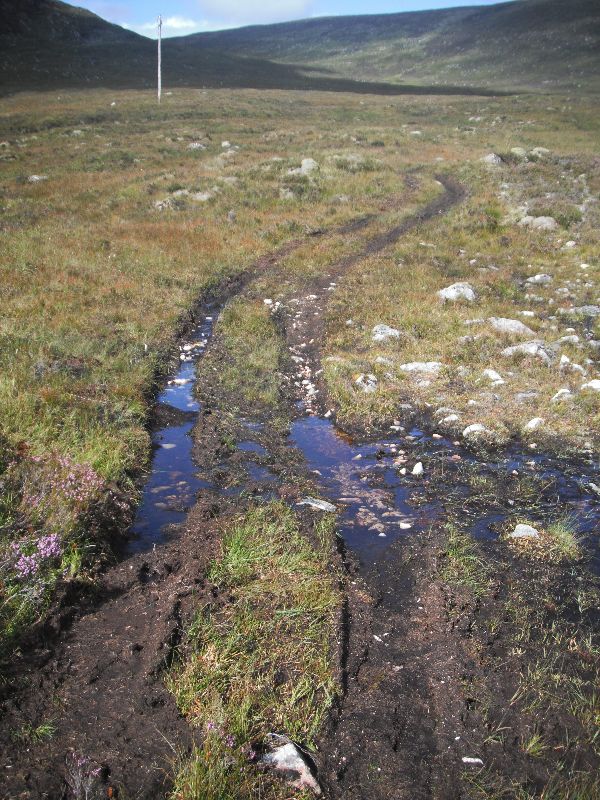
George Allan
A whole edition of Mountain Views could be filled with the activity surrounding the Scottish Environment LINK's Hill Tracks Campaign, the key players in which remain NEMT, The Ramblers and The Scottish Wild Land Group. Of particular concern recently have been various new or reconstructed tracks in the Clova and Prosen area, some of which appear to be unauthorised. The Campaign continues to ask hill-goers to submit information about tracks they are concerned about at http://www.scotlink.org/workareas/hill-tracks. The following gives a flavour of the various aspects of this work.
In the spring of 2018, LINK will produce its report providing a critique of the Prior Notification system and its application in practice. This will be followed by campaigning work based on the findings and associated recommendations. To take this forward, and to help in the meantime with coordinating the tracking of planning authority websites for applications, LINK has employed Mel Nicoll on a part time basis. Mel will be known to many as she is also the John Muir Trust's Campaign Coordinator.
A Scotland-wide network of 'trackers' keep LINK advised of relevant applications. One such was a Prior Notification for a track in the glen running north east from Camusrory, in the heart of wildest Knoydart (Wild Land Area 18). The proposed work was for the upgrading of existing tracks and the construction of new tracks along sections where argocats have been used causing significant damage to the ground (described as 'the peat tracks'). NEMT contacted Highland Council to say that the proposals should not be considered under the Prior Notification system as the applicant acknowledged that the purpose was deer management and tracks for this are not permitted development. Highland Council agreed and rejected the application.
A full planning application has now been submitted and this has ensured that Scottish Natural Heritage and the Scottish Environmental Protection Agency have had the opportunity to comment and that a Landscape and Visual Impact Assessment has been prepared. NEMT has raised a number of issues including the width of the track, the need for a central vegetation strip to reduce the visual impact and the importance of Highland Council inspecting the quality of the work should the application be approved. NEMT's position on the application is summarised in this statement from its submission:
This application presents a dilemma for Highland Council. Creating new tracks in this area, and the 'peat tracks' almost certainly should be considered as new, is highly undesirable on landscape grounds. However, the estate's use of vehicles over peat has left sections which are an ugly mess and well constructed, narrow tracks may, in the long run, be less visually detrimental.
A decision is awaited at the time of writing.
 |
| Damage caused by ATVs in Argyll - a growing problem © George Allan |
The Campaign's focus is the new Prior Notification system but more and more members of the public have passed on concerns about poor restoration work in respect of tracks to small scale hydro schemes. Many of these are blighting previously unspoilt glens. LINK is intending to comment on these in its report. The Munro Society is working with Mountaineering Scotland to monitor how well recently constructed tracks have been restored and how these blend in over time.
LINK and the Munro Society is looking to hill goers to provide information and photos to help this monitoring. These should be sent to both the LINK Hill Tracks Campaign (hilltracks@scotlink.org) and to the Munro Society via its website and marked for the attention of Jim Robertson.
To facilitate improvements in digital communications, the Scottish Government has changed the law so that masts and associated infrastructure no longer require full planning consent in certain circumstances and now come under Prior Notification arrangements, a much lesser form of control. In open country, tracks are often needed for the construction of communication masts and this aspect of the work is often given scant attention despite it being the most visually intrusive. NEMT has written to the Minister stating that any guidance regarding the new system should emphasise the importance of planning authorities giving due regard to the tracks. This letter also raised concerns that further intended changes to legislation include the possibility of allowing communications infrastructure proposed for 'designated' areas to also come under the Prior Notification system. NEMT argued that planning authorities must retain the right to refuse such applications where these would undermine the environmental or visual integrity for which the area had been designated. We have received a reply noting our concerns.
In the last edition of Mountain Views, we applauded the Park for beginning to take a more robust approach to enforcement where recalcitrant land owners/managers flout the legislation regarding tracks. The Park has begun to demonstrate its mettle; it has taken enforcement action on a section of unauthorised track on Carn an Leth-choin in the Monadliath (requiring the removal of a track and its reinstatement to argocat tramlines and the restoration of borrow pits) and issuing a planning contravention notice in respect of a track behind the Clova Hotel which appears to be for the construction of a small scale hydro project and which should have been removed.
The Park has also stated its opposition to the construction of any more new tracks within its boundaries; NEMT welcomes this but how this sits within the law has yet to work out in practice.
Please let the webmaster know if there are problems with viewing these pages or with the links they contain.